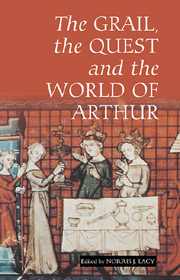Book contents
- Frontmatter
- Contents
- List of Illustrations
- Notes on Contributors
- Foreword
- Introduction: Arthur and/or the Grail
- 2 The Shape of the Grail in Medieval Art
- 3 The Crusaders' Grail
- 4 Bounds of Imagination: Grail Questing and Chivalric Colonizing in Wolfram von Eschenbach's Parzival
- 5 The Land without the Grail: A Note on Occitania, Rigaut de Barbezieux and Literary History
- 6 Female Desire and the Quest in the Icelandic Legend of Tristram and Ísodd
- 7 Questing in the Middle Dutch Lancelot Compilation
- 8 Keeping Company: Manuscript Contexts for Reading Arthurian Quest Narratives
- 9 Grail and Quest in the Medieval English World of Arthur
- 10 Malory and the Grail: The Importance of Detail
- 11 Glastonbury, the Grail-Bearer and the Sixteenth-Century Antiquaries
- 12 The Grail Quest: Where Next?
- Appendix: The Grail on Film
- Index
- Analysis of grail scenes
- Arthurian Studies
10 - Malory and the Grail: The Importance of Detail
Published online by Cambridge University Press: 05 February 2013
- Frontmatter
- Contents
- List of Illustrations
- Notes on Contributors
- Foreword
- Introduction: Arthur and/or the Grail
- 2 The Shape of the Grail in Medieval Art
- 3 The Crusaders' Grail
- 4 Bounds of Imagination: Grail Questing and Chivalric Colonizing in Wolfram von Eschenbach's Parzival
- 5 The Land without the Grail: A Note on Occitania, Rigaut de Barbezieux and Literary History
- 6 Female Desire and the Quest in the Icelandic Legend of Tristram and Ísodd
- 7 Questing in the Middle Dutch Lancelot Compilation
- 8 Keeping Company: Manuscript Contexts for Reading Arthurian Quest Narratives
- 9 Grail and Quest in the Medieval English World of Arthur
- 10 Malory and the Grail: The Importance of Detail
- 11 Glastonbury, the Grail-Bearer and the Sixteenth-Century Antiquaries
- 12 The Grail Quest: Where Next?
- Appendix: The Grail on Film
- Index
- Analysis of grail scenes
- Arthurian Studies
Summary
The word grail is generally used nowadays to mean something unknown but supremely important and desirable, which, if it can be discovered, will transform the world in which the grail exists. So, for instance, it could be said that the Holy Grail of twentieth-century physics was a ‘Theory of Everything’. This use of the word grail is a metaphorical development of stories that grew up in the Middle Ages within the Arthurian legend. The metaphorical sense fits all of them, but they have little else in common. As R.S. Loomis said, they seem to delight in contradicting each other on important points: on the number of kings in the Grail castle, their names, their physical state, the cause and exact nature of ‘the Waste Land’, the name of the successful hero, and the form and attributes of the Grail itself. We might add to Loomis's list that they also disagree about the objects and ceremonies associated with the Grail, where it is to be found, what the hero has to do to ‘achieve’ it and the nature of the transformation that the achievement will bring about.
Their treatment of the Grail itself illustrates that range of variation. Richard O'Gorman, in an essay in the standard reference work, listed the forms that the grail takes in the principal texts. His list presents some problems, but they do not affect the present argument. He notes that the earliest surviving Grail romance, Chrétien de Troyes's Perceval, introduces the central object not as the Grail but as a grail, which suggests that it was not unique but a member of a class of objects that Chrétien's audience would be able to visualize.
- Type
- Chapter
- Information
- The Grail, the Quest, and the World of Arthur , pp. 141 - 155Publisher: Boydell & BrewerPrint publication year: 2008



